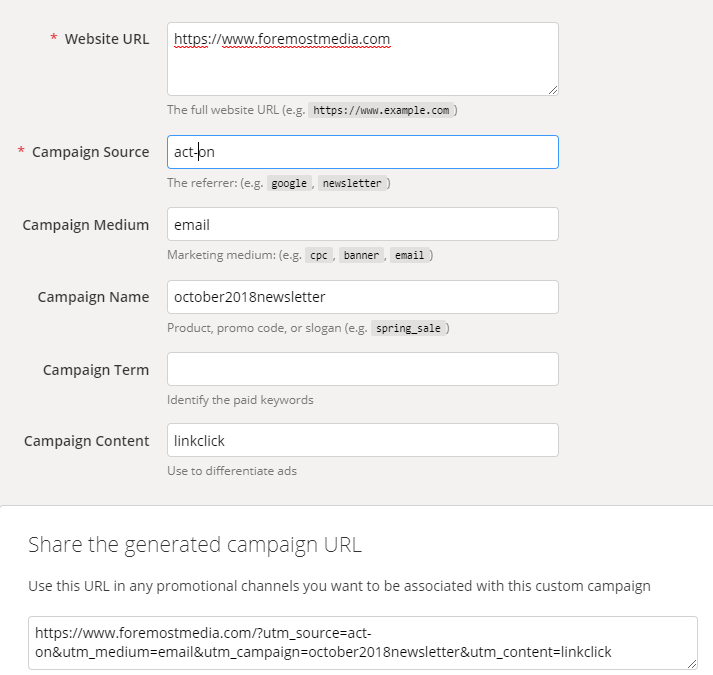Have you ever run a campaign and wondered how effective it was at driving traffic to your website? You did append UTM tags to the links in the campaign, didn’t you? If not, Google Analytics reports will not contain the data you need to measure campaign performance.
That’s why UTM codes (also known as UTM tags or UTM parameters) are so important.
UTM Parameters: What Are They?
UTM parameters are attributes you append to hyperlinks (destination URLs) for marketing campaigns sending traffic to your website. When the link is clicked and the visitor arrives on your site, tags are sent back to your Google Analytics Account and appear in your Analytics metrics.
Here is a sample link we could use when this blog is shared in an email blast; the UTM parameters are appended to the URL): https://www.foremostmedia.com/?utm_source=act-on&utm_medium=email&utm_campaign=october2018newsletter&utm_content=linkclick
Why Use Them?
Failure to append UTM tags to hyperlinks will do more than simply hinder your ability to do effective campaign analysis.
Without UTM codes, Google Analytics might register that the link a user clicked was from an email blast, but it certainly will not be able to tell you which campaign a user came from. It is important to note this does not just apply to email marketing. This applies to any link you create that is sending users back to your website including; a Facebook post, Facebook Ad, LinkedIn post, LinkedIn Ad, a tweet, YouTube video descriptions, PDF documents and so much more.
The Five UTM Parameters Available for Campaign Tracking in Google Analytics
Before discussing how to create the UTM parameter tags, let’s first look at the five parameters available.


Easiest Method to Add UTM Parameters to URLs
You can manually append UTM parameters to URLs, but it’s much easier to use Campaign URL Builder. Just fill in the form, click “Copy URL”, and the tagged URL will be copied for you to use in your digital materials.
Where To View Campaign Data
You can view campaign data in Google Analytics via Acquisitions > Campaigns > All Campaigns. Click on each Campaign Name (which corresponds to the utm_campaign parameter in your UTM-tagged URLs) to see which links are generating traffic.


A few tricks and tips:
1. Garbage In, Garbage Out
Keep track of the UTM parameters that you’ve used in the past and keep your labeling system as consistent as possible. Make sure all tags are human-readable.
We recommend using lowercase letters as the campaign name is case sensitive in Google’s eyes. Facebook and facebook are two different terms even though they’re spelled the same.
2. No Need to Tag AdWords URLs (Optional)
Google strongly recommends that users use auto-tagging and link Google Analytics with Google AdWords. If this is done, there is no need to (UTM) tag AdWords URLs. With the accounts linked, Google automatically tags AdWords campaigns and imports all AdWords campaign data into Google Analytics. I would argue this case if you are looking to capture these UTM parameters from a contact form submission or newsletter signup. If you do not tag Google Ads you would only be able to capture the GCLID and would not get any keyword information. You can upload GCLID information back into Google Ads, but it can be time consuming. It is also important to capture this information in contact forms because you can start to attribute ROI to each campaign that you run.
3. Never Use UTM Parameters to Track Links Inside Your Own Website
Do not use UTM parameters to track clicks on links within your website. Doing so will cause Google Analytics to restart the session for the same visitor, causing the visit to be double-counted with new referrer information. Additionally, you will be unable to trace any subsequent transactions or goal completions to the original referring source and/or medium.
Where To Go Next?
So now that you have UTM parameters working for you and helping you show campaign performance, the next step is to capture those URL parameters. You might be asking how we capture those URL parameters. Read our next blog about storing those URL parameters and getting them to submit with; a contact form, newsletter signup or anything that allows a user to submit information.